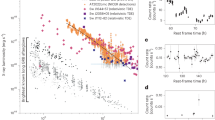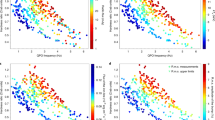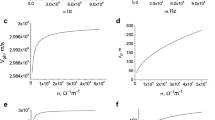Abstract
Unexpectedly strong X-ray emission from extragalactic radio jets on kiloparsec scales has been one of the major discoveries of Chandra, the only X-ray observatory capable of sub-arcsecond-scale imaging. The origin of this X-ray emission, which appears as a second spectral component from that of the radio emission, has been debated for over two decades. The most commonly assumed mechanism is inverse-Compton upscattering of the cosmic microwave background by very low-energy electrons in a still highly relativistic jet. Under this mechanism, no variability in the X-ray emission is expected. Here we report the detection of X-ray variability in the large-scale jet population, using a novel statistical analysis of 53 jets with multiple Chandra observations. Taken as a population, we find that the distribution of P values from a Poisson model is strongly inconsistent with steady emission, with a global P value of 1.96 × 10−4 under a Kolmogorov–Smirnov test against the expected uniform (0, 1) distribution. These results strongly imply that the dominant mechanism of X-ray production in kiloparsec-scale jets is synchrotron emission by a second population of electrons reaching multi-teraelectronvolt energies. X-ray variability on the timescale of months to a few years implies extremely small emitting volumes much smaller than the cross-section of the jet.
This is a preview of subscription content, access via your institution
Access options
Access Nature and 54 other Nature Portfolio journals
Get Nature+, our best-value online-access subscription
$32.99 / 30 days
cancel any time
Subscribe to this journal
Receive 12 digital issues and online access to articles
$119.00 per year
only $9.92 per issue
Buy this article
- Purchase on SpringerLink
- Instant access to full article PDF
Prices may be subject to local taxes which are calculated during checkout



Similar content being viewed by others
Data availability
All observations used in this study are publicly available. In particular, the Chandra X-Ray Observatory archive can be accessed on the web at https://cda.harvard.edu/chaser/. Radio observations with NRAO facilities are available at https://data.nrao.edu, ACTA observations from https://atoa.atnf.csiro.au/. Extensive tables of reduced data necessary to repeat these analyses are available as supplementary Excel files, further described in Supplementary Section 3.g
Code availability
References
Reddy, K., Georganopoulos, M., Meyer, E. T., Keenan, M. & Kollmann, K. E. Offsets between X-ray and radio components in X-ray jets: the AtlasX. Astrophys. J. Suppl. Ser. 265, 8 (2023).
Schwartz, D. A. et al. Chandra discovery of a 100 kiloparsec X-ray jet in PKS 0637-752. Astrophys. J. Lett. 540, 69–72 (2000).
Chartas, G. et al. The Chandra X-Ray Observatory resolves the X-ray morphology and spectra of a jet in PKS 0637-752. Astrophys. J. 542, 655–666 (2000).
Tavecchio, F., Maraschi, L., Sambruna, R. M. & Urry, C. M. The X-ray jet of PKS 0637-752: inverse Compton radiation from the cosmic microwave background? Astrophys. J. Lett. 544, L23–L26 (2000).
Celotti, A., Ghisellini, G. & Chiaberge, M. Large-scale jets in active galactic nuclei: multiwavelength mapping. Mon. Not. R. Astron. Soc. 321, L1–L5 (2001).
Marshall, H. L. et al. A flare in the jet of Pictor A. Astrophys. J. Lett. 714, L213–L216 (2010).
Hardcastle, M. J. et al. Deep Chandra observations of Pictor A. Mon. Not. R. Astron. Soc. 455, 3526–3545 (2016).
Thimmappa, R. et al. Chandra imaging of the western hotspot in the radio galaxy Pictor A: image deconvolution and variability analysis. Astrophys. J. 903, 109 (2020).
Hardcastle, M. J. et al. The nature of the jet-driven outflow in the radio galaxy 3C 305. Mon. Not. R. Astron. Soc. 424, 1774–1789 (2012).
Hardcastle, M. J., Massaro, F. & Harris, D. E. X-ray emission from the extended emission-line region of the powerful radio galaxy 3C 171. Mon. Not. R. Astron. Soc. 401, 2697–2705 (2010).
Feigelson, E. D. et al. The X-ray structure of Centaurus A. Astrophys. J. 251, 31–51 (1981).
Kraft, R. P. et al. Chandra observations of the X-ray jet in Centaurus A. Astrophys. J. 569, 54–71 (2002).
Wilson, A. S., Young, A. J. & Shopbell, P. L. Chandra observations of Cygnus A: magnetic field strengths in the hot spots of a radio galaxy. Astrophys. J. Lett. 544, L27–L30 (2000).
Harris, D. E. et al. Flaring X-ray emission from HST-1, a knot in the M87 jet. Astrophys. J. Lett. 586, L41–L44 (2003).
Hardcastle, M. J. & Croston, J. H. The Chandra view of extended X-ray emission from Pictor A. Mon. Not. R. Astron. Soc. 363, 649–660 (2005).
Georganopoulos, M., Kazanas, D., Perlman, E. & Stecker, F. W. Bulk Comptonization of the cosmic microwave background by extragalactic jets as a probe of their matter content. Astrophys. J. 625, 656–666 (2005).
Georganopoulos, M., Perlman, E. S., Kazanas, D. & McEnery, J. Quasar X-ray jets: gamma-ray diagnostics of the synchrotron and inverse Compton hypotheses: the case of 3C 273. Astrophys. J. Lett. 653, L5–L8 (2006).
Alves, E. P., Zrake, J. & Fiuza, F. Efficient nonthermal particle acceleration by the kink instability in relativistic jets. Phys. Rev. Lett. 121, 245101 (2018).
Marshall, H. L. et al. A Chandra survey of quasar jets: first results. Astrophys. J. Suppl. Ser. 156, 13–33 (2005).
Zhu, S. F., Brandt, W. N., Wu, J., Garmire, G. P. & Miller, B. P. Investigating the X-ray enhancements of highly radio-loud quasars at z > 4. Mon. Not. R. Astron. Soc. 482, 2016–2038 (2019).
Marshall, H. L. et al. An X-ray imaging survey of quasar jets: testing the inverse Compton model. Astrophys. J. Suppl. Ser. 193, 15 (2011).
Marshall, H. L. et al. An X-ray imaging survey of quasar jets: the complete survey. Astrophys. J. 856, 66 (2018).
Worrall, D. M. et al. Inverse-Compton scattering in the resolved jet of the high-redshift quasar PKS J1421-0643. Mon. Not. R. Astron. Soc. 497, 988–1000 (2020).
Schwartz, D. A. et al. Two candidate high-redshift X-ray jets without coincident radio jets. Astrophys. J. 904, 57 (2020).
Ighina, L. et al. Direct observation of an extended X-ray jet at z = 6.1. Astron. Astrophys. 659, A93 (2022).
Meyer, E. T. et al. The origin of the X-ray emission in two well-aligned extragalactic jets: the case for IC/CMB. Astrophys. J. Lett. 883, L2 (2019).
Breiding, P. et al. Fermi non-detections of four X-ray jet sources and implications for the IC/CMB mechanism. Astrophys. J. 849, 95 (2017).
Breiding, P. et al. A multiwavelength study of multiple spectral component jets in AGN: testing the IC/CMB model for the large-scale-jet X-ray emission. Mon. Not. R. Astron. Soc. 518, 3222–3250 (2023).
Dermer, C. D. On the beaming statistics of gamma-ray sources. Astrophys. J. Lett. 446, L63 (1995).
Georganopoulos, M., Kirk, J. G. & Mastichiadis, A. The beaming pattern and spectrum of radiation from inverse Compton scattering in blazars. Astrophys. J. 561, 111–117 (2001).
Harris, D. E., Cheung, C. C., Stawarz, Ł., Biretta, J. A. & Perlman, E. S. Variability timescales in the M87 jet: signatures of E2 losses, discovery of a quasi period in HST-1, and the site of TeV flaring. Astrophys. J. 699, 305–314 (2009).
Snios, B. et al. Variability and proper motion of X-ray knots in the jet of Centaurus A. Astrophys. J. 871, 248 (2019).
Giannios, D., Uzdensky, D. A. & Begelman, M. C. Fast TeV variability in blazars: jets in a jet. Mon. Not. R. Astron. Soc. 395, L29–L33 (2009).
Mossman, A., Stohlman, O., Cheung, T., Harris, D. E. & Massaro, F. XJET: X-Ray Emission from Extragalactic Radio Jets https://hea-www.harvard.edu/XJET/ (2015).
Garmire, G. P. et al. Advanced CCD imaging spectrometer (ACIS) instrument on the Chandra X-ray Observatory. Proc. SPIE 4851, 28–44 (2003).
Fruscione, A. et al. CIAO: Chandra’s data analysis system. Proc. SPIE 6270, 62701V (2006).
McMullin, J. P., Waters, B., Schiebel, D., Young, W., & Golap, K. in Astronomical Data Analysis Software and Systems XVI Vol. 376 (eds Shaw, R. A. et al.) 127–130 (ASP, 2007).
HI4PI Collaboration et al. HI4PI: a full-sky H i survey based on EBHIS and GASS. Astron. Astrophys. 594, A116 (2016).
Fraser, D. A. S., Reid, N. & Sartori, N. Accurate directional inference for vector parameters. Biometrika 103, 625–639 (2016).
Davison, A. C. & Reid, N. The tangent exponential model. Preprint at https://arxiv.org/abs/2106.10496 (2021).
Davison, A. C., Fraser, D. A., Reid, N. & Sartori, N. Accurate directional inference for vector parameters in linear exponential families. J. Am. Stat. Assoc. 109, 302–314 (2014).
Acknowledgements
The following grant funding is acknowledged: Chandra Archival Grant 16700615 (E.T.M.), ADAP grant NNX15AE55G (E.T.M.) and NSF grant 1714380 (E.T.M.), as well as support from the Natural Sciences and Engineering Research Council of Canada, grant ID RGPIN-2020-05897 (Y.T. and N.R.). This research was made possible through use of data obtained from the Chandra Data Archive and the Chandra Source Catalog, and software provided by the Chandra X-Ray Center (CXC) in the application packages CIAO and sherpa. The Australia Telescope Compact Array is part of the Australia Telescope National Facility, which is funded by the Australian Government for operation as a national facility managed by CSIRO. We acknowledge the Gomeroi people as the traditional owners of the observatory site. This paper makes use of the following ALMA data sets: 2012.1.00688.S, 2016.1.01481.S. ALMA is a partnership of ESO (representing its member states), NSF (USA) and NINS (Japan), together with NRC (Canada), MOST and ASIAA (Taiwan), and KASI (Republic of Korea), in cooperation with the Republic of Chile. The Joint ALMA Observatory is operated by ESO, AUI/NRAO and NAOJ. The NRAO is a facility of the National Science Foundation operated under cooperative agreement by Associated Universities, Inc.
Author information
Authors and Affiliations
Contributions
E.T.M. conceived the project, developed the data analysis methods, contributed to the multiwavelength data analysis and wrote the paper. A.S. carried out the X-ray data analysis with contributions from E.T.M., K.R., P.B., N.D., D.C. and M.T. Y.T. and N.R. contributed the statistical analysis methods and expertise. K.R. and P.B. contributed to the data analysis and interpretation. M.G. contributed to the interpretation and theoretical implications. All authors contributed to the editing of the paper and interpretation of results.
Corresponding author
Ethics declarations
Competing interests
The authors declare no competing interests.
Peer review
Peer review information
Nature Astronomy thanks the anonymous reviewers for their contribution to the peer review of this work.
Additional information
Publisher’s note Springer Nature remains neutral with regard to jurisdictional claims in published maps and institutional affiliations.
Extended data
Extended Data Fig. 1
Histogram of the single-region p-values for the full sample of 155 regions. The distribution shows an excess at low values relative to the expected uniform (0, 1) distribution, indicating variability in the population.
Extended Data Fig. 2 Histogram of the percent difference of each epoch source rate from \(\bar{\mu }\) for all regions.
Including all epochs on all regions, there are 545 distinct observations. The distribution has a mean of 1.02% and a standard deviation of 28.5%. The mean of the absolute value of the percent difference is 18%.
Supplementary information
Supplementary Information
Supplementary Figs. 1–5, Table 1, Methods, Discussion and description of Supplementary Tables 2–5.
Supplementary Data 1
Supplementary Tables 2–5.
Rights and permissions
Springer Nature or its licensor (e.g. a society or other partner) holds exclusive rights to this article under a publishing agreement with the author(s) or other rightsholder(s); author self-archiving of the accepted manuscript version of this article is solely governed by the terms of such publishing agreement and applicable law.
About this article
Cite this article
Meyer, E.T., Shaik, A., Tang, Y. et al. Variability of extragalactic X-ray jets on kiloparsec scales. Nat Astron 7, 967–975 (2023). https://doi.org/10.1038/s41550-023-01983-1
Received:
Accepted:
Published:
Issue date:
DOI: https://doi.org/10.1038/s41550-023-01983-1
This article is cited by
-
Variability and synchrotron emission
Nature Astronomy (2023)



